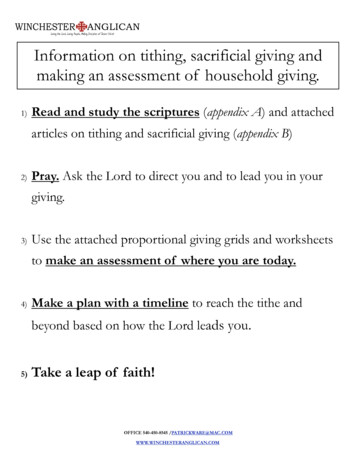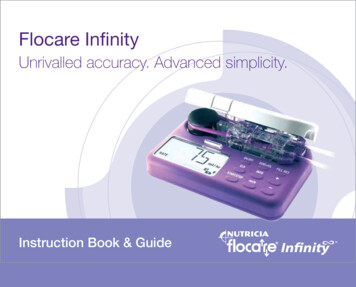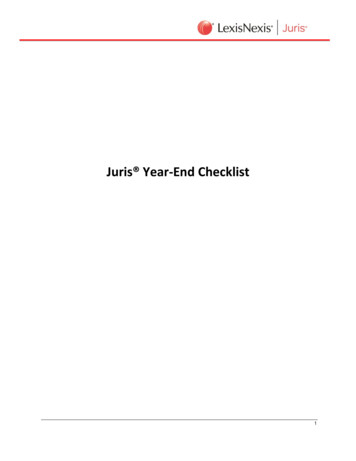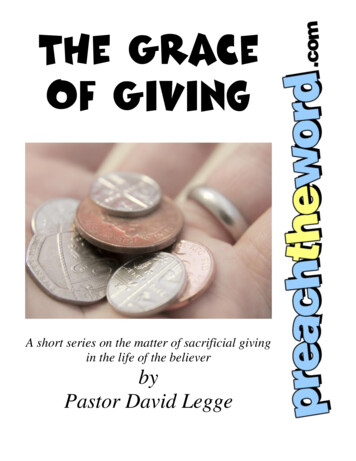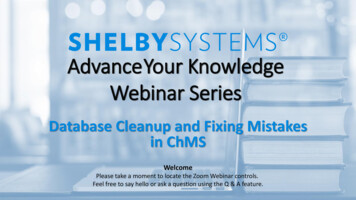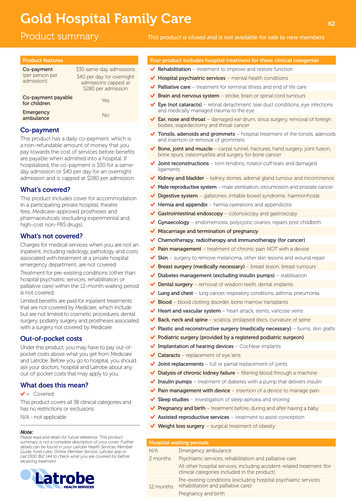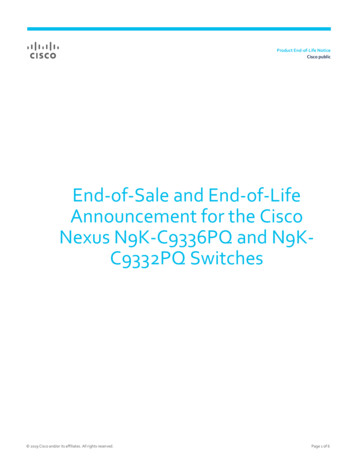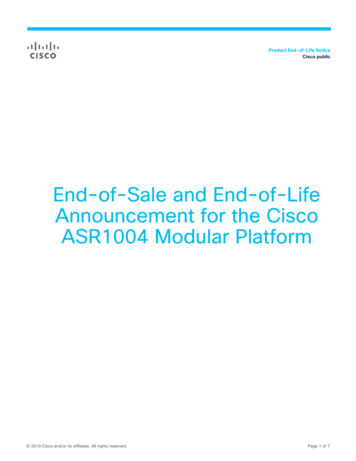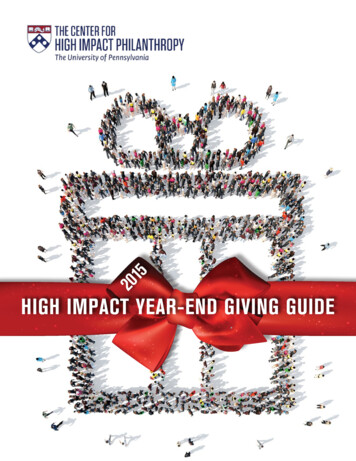
Transcription
1520HIGH IMPACT YEAR-END GIVING GUIDE
About the CenterThe Center for High Impact Philanthropy (CHIP) helps donors understand how their giving can do the most good. Founded as acollaboration between the School of Social Policy & Practice and Wharton School of Business alumni, CHIP independently identifiesphilanthropic approaches and models that yield high social impact, with the goal of delivering actionable guidance for funders. It providespublic information, education programs and advisory services on a range of causes such as early childhood development, child survival,malaria, disaster relief, addiction, hunger, housing, urban blight, and obesity. CHIP’s multidisciplinary team is an authority on measuringand managing social impact, no matter the cause. To learn more, visit www.impact.upenn.edu.About Our Platinum SponsorsSince Fidelity Charitable’s inception as a public charity in 1991, its missionhas remained the same—to further the American tradition of philanthropyby providing programs that make charitable giving simple, effective, andaccessible. Fidelity Charitable launched the first national donor-advisedfund program, democratizing philanthropy by making a giving vehicleavailable to a broad array of people. Since its founding, Fidelity Charitablehas helped more than 120,000 donors support over 217,000 nonprofit organizations with more than 21 billion in grants.The Annie E. Casey Foundation is devoted to developing a brighter future for millions of children at risk of poor educational, economic, social,and health outcomes. The foundation advances research and solutions toovercome the barriers to success, helps communities demonstrate whatworks, and influences decision makers to invest in strategies based on solidevidence. Since 1948, these efforts have translated into more informed policies and practices and yielded positive results for larger numbers of kidsand families.
Contentsopportunitiesfor impact5 poverty6 neonatal mortality7 food insecurityGiving the mostvulnerable a chance ateconomic securityCurbing newborndeaths in thedeveloping worldAddressing hungerin one of the world’srichest countries8 essential support9 neglected lots10 in treatmentNurse home visits forlow-income, first-timemothersCombatingneighborhood blightStabilizing the livesof drug-dependentwomen and their kids11 summer slide12 our drug epidemic14 disaster reliefStemming summerlearning loss forlow-income kidsPreventing deathsfrom heroin andpainkiller overdosesOur annual look atgroups working withdisplaced populationsresourceslearn moreabout18 t ips to turn year-end giving intoyear-round impact19 tips for avoiding fraud16 overlookedopportunity for impactChildren’s EnvironmentalHealth20 m ore resources for identifyingnonprofits to support22 our additional work23 nonprofits mentioned in this guideThe Center for High Impact Philanthropy3
In This GuideAround the world, the end of the year is a time ofcelebration and giving. In the United States, anestimated 75 billion—one-quarter of all philanthropicgifts—will be made between Thanksgiving and NewYear’s. In time for this all-important season, we presentour fifth-annual High Impact Year-End Giving Guide,developed for those who want to understand how theirgifts can make as great a difference as possible.In the beginning pages of this guide youwill find seven specific high impact opportunities handpicked by our team and analyzedfor evidence of impact and cost-effectiveness (pages 5 to 11). With each opportunity, we provide background on a specificcause, an organization working effectively in that space, and suggestions of waysto contribute to the charity and/or cause.There’s something for every budget: 7 canprovide a home-based newborn care package (HBNC), one of the most cost-effectiveways to save a newborn life in the develop-4The Center for High Impact Philanthropying world; 10 to 30 affords weekly mealsfor a family of four; 25 to 350 can help alow-income student avoid the ‘summer slide’that contributes so much to our wideningachievement gap between low-income students and their wealthier peers.Also included in these pages is our perennial Disaster Relief guide (page 14). Itprovides things to remember about the challenges of disaster relief and a list of key organizations around the world working to createcontinued stability for displaced populations.Additionally, we offer a briefing of our mostrecent report, “Lifting the Burden of Addiction: Philanthropic Opportunities to AddressSubstance Use Disorders in the U.S.” (page12). The face of addiction has changed overthe past decade, with an alarming rise inopioid addiction. We highlight three organizations working to reduce addiction’s enormous human and economic toll.Lastly, we present a primer on an evolvingand often overlooked field: early childhoodenvironmental health. Funders, researchers,and practitioners often think and work on early childhood development and environmentalconcerns separately. However, addressingearly childhood and environmental health together can make a huge difference given thelong-lasting dangers associated with exposingchildren to toxic chemicals in their first 1,000days. There’s much to learn about how our useof the environment affects the next generationof children, and we offer suggestions (page 16)on how donors can support existing efforts.In our closing pages, to help you make asinformed a choice as possible, we offer general tips on how to turn year-end giving intoyear-round impact (page 18), suggestions onhow to avoid fraud (page 19) and more resources for identifying nonprofits to support(page 20).The season of giving is upon us. Here’s tomaking every penny of that giving count forthose in need. Happy Holidays and HappyGiving.Founding Executive Director2015 High Impact Year-End Giving Guide
PovertyGiving the most vulnerable a chance at economic stabilityUltra poverty is an inability to meet even the barest of basic needs. Oneeffective model to fight extreme poverty was developed over a decadeago by the Bangladesh Rural Advancement Committee (BRAC). Itsholistic approach provides the poor with physical assets (such as livestock or a loom necessary to start a small business); support (through weeklycoaching visits, money or food to prevent the loss of the asset); and networks tohelp with decision-making. Participants eventually “graduate” the program andbecome economically stable. This graduation model has since been adapted tosome 20 countries. Here we profile one such program in Haiti.nonprofit making an impactR Fonkoze’s ChemenLavi Miyò (CLM)What It Does Haitian women in extreme poverty live on less than 1 per day,often have multiple children, no assets,no healthcare, and suffer from persistenthunger. CLM’s case managers work withwomen with no financial means for 18months to help them build skills and greater confidence. Chemen Lavi Miyo, whichtranslates to “Pathway to a Better Life,”provides each member with the materialsto construct a 9 9 meter home with a sturdy roof and a latrine; a water filter; and herchoice of two activities to begin earning anincome, including raising various types oflivestock or merchandise to sell. (See beforeand after photo of home, below.)How Effective Is It Since 2006, CLMhas empowered more than 3,600 ultra-poor women; 97% of participants successfully “graduated” the program, allowing for a modest but significant changefor themselves and their families. Recentrandomized controlled studies of thisgraduation approach following more than20,000 people in seven countries foundimprovements in key indicators such asfood security, assets, and income that lasted after the program ended.How You Can Help In Haiti, the costis an estimated 1,600 to move a womanfrom ultra-poverty to increased economic security. A 2015 cost-benefit analysisby researchers found that the estimatedbenefits exceeded the program costs in amajority of the countries where the graduation model was examined. In most sites,additional earnings made by participatingfamilies were greater than the cost of theprogram.Personalize This Project You canfund Fonkoze, BRAC in Bangladesh, orsimilar groups such as BOMA Project inKenya or Trickle Up in India. Or go to theConsultative Group to Assist the Poor’s(CGAP)’s information-rich web site, blog,and community of practice for additionalcountries and sites.Tips Look for organizations that go beyond financial capital to help clients buildtheir skills, networks, and assets, which areas important as income. Productive assets,like farm tools, goats, or weaving looms,increase people’s ability to generate anincome. Non-productive assets like housing help reduce risks and improve clients’ability to recover from economic crises.For more information on this model andour analysis, see our profile of Fonkozeand the Graduation Model in our Haiti Guide at: http://www.impact.upenn.edu/?p 1822.Fonkoze: www.fonkoze.orgBRAC: www.brac.netBoma Project: www.bomaproject.orgSinfora Pierre, a CLM client, stands in front of her original wall-less rusty-roofed house and next to the house she constructedwith support from the CLM program.2015 High Impact Year-End Giving GuideTrickle Up: www.trickleup.orgCGAP: www.cgap.orgThe Center for High Impact Philanthropy5
Neonatal MortalityCurbing newborn deaths in the developing worldAround the world, almost three million newborns die in their first monthof life every year. Ninety-nine percent of these deaths take place indeveloping countries. Yet, most can be prevented with proven andcost-effective interventions such as delivering Home-Based Newborn Care (HBNC) packages to vulnerable populations at the community level.These interventions are straightforward, such as home visits during the first 28days of life, using sterile blades to cut umbilical cords, teaching mothers the importance of immediate breastfeeding, treating infections, and keeping newbornbabies warm. Here we profile the group in rural India that pioneered HBNCpackages 15 years ago as a way to reduce neonatal mortality rates. Its work hassince been adapted by additional humanitarian organizations and governmentsand has spread throughout India and to countries in Africa and South Asia.nonprofit making an impactAction and Researchin Community Health(SEARCH)6Personalize This Project Similarprograms established around the worldinclude JSI Research & Training Institute(Nepal), BRAC (Bangladesh), and Save theChildren’s Saving Newborn Lives Initiative(Bangladesh, Democratic Republic of Congo, Ethiopia, India, Nepal, Nigeria, Malawiand Uganda).Tips In many parts of the world, there arecomplex traditional local beliefs, taboos,and practices surrounding pregnancy andchildbirth. It is crucial that organizationstake these into account when adaptingHBNC for different populations. To ensure that HBNC is accepted and utilized bycommunity members, it is equally important that organizations choose health workers that are acceptable to the community.Look for programs that are already focusedon maternal and children’s health, as theyare well-positioned to integrate HBNCpackages into their roster of offerings.R S ociety for Education,What It Does This organization foundedthree decades ago by two Indian physiciansdelivers maternal and newborn health careto nearly 40 villages in western India. Ruralwomen trained as Village Health Workers(VHWs) provide basic care for expectingmothers and newborn children, as well ashealth education to women in their communities. VHWs are trained to identify andtreat neonatal morbidities such as asphyxia,prematurity, low birth weight, sepsis, hypothermia, and infection.VHWs educate pregnant mothers, arepresent at birth, and then visit new mothersand babies in their homes repeatedly duringthe first crucial weeks of life, equipped witha neonatal care kit that includes simple butlife-saving equipment such as blankets, aresuscitation bag and mask, soap, a thermometer, weighing scale, and medicationsto manage infections. In addition to diagnosing problems, VHWs monitor the baby’s growth and ensure that the mother hassupport in healthy behaviors such as earlybreastfeeding, keeping the baby warm, andmaintaining good hygiene. SEARCH alsoplays an important role as a training site—tive: the cost per newborn life saved is approximately 150; amount per mother-newborn pair served is approximately 7. Donorscan give to SEARCH through the US-based501c3 Indians for Collective Action (findSEARCH in the drop-down menu). Or visitthe “contact us” page of the SEARCH website for an address to send a check.the organization has developed a range ofinstructional materials to teach the trainersof 800,000 VHWs (called ASHAs) of theGovernment of India, and the NGO workerswithin India and around the world onsite inGadchiroli, Maharashtra.How Effective Is It Newborn deaths, asmeasured by neonatal mortality rate, decreased by 70% in SEARCH villages compared to control areas during an evaluationbetween the years 1993 and 2003. Additionally, maternal morbidities in SEARCHintervention areas were reduced by 49%.How You Can Help When comparedwith other interventions targeting newbornhealth, HBNC is one of the most cost-effec-The Center for High Impact PhilanthropyFor more information on this model andour analysis, see our profile of SEARCHin Child Survival: Guidance for Donors athttp://www.impact.upenn.edu/?p 1833Indians for Collective Action www.icaonline.org/donate (Find SEARCH in the drop-down menu)JSI Research & Training Institutewww.jsi.comBRAC www.brac.netSave the Children’s Saving NewbornLives Initiative 4293/k.7FC1/Newborn Health.htm2015 High Impact Year-End Giving Guide
Food InsecurityAddressing hunger in one of the world’s richest countriesretail. In 2014, Feeding America providedfood to 46 million Americans, including12 million children and 7 million seniors.How You Can Help Through its network of food banks, Feeding America canhelp provide meals for a family of four foras little as 8 to 28 per week. The USDAestimates the retail cost of feeding thatfamily at 131 to 255—or more for aweek of healthy meals, depending on themix of items purchased. Feeding America’s Ways to Give web page has a monthlygiving program, plus fundraising ideas.Personalize This Project FeedingAmerica’s website has a food bank locater.Simply enter your zip code or state to findyour local food bank and other emergency food providers: ven with improvements in unemployment rates and the overall economyover the past few years, hunger in America remains as pervasive asin recessionary times. Last year, 14% of U.S. households were foodinsecure meaning they found it difficult or impossible to access enoughsustenance for an adequate diet, compared with 14.6% in 2008. Food banksand other organizations that can leverage national and local partnerships acrossthe supply chain can secure food at costs well below retail prices. Here’s onegroup providing items more cost-effectively than conventional food drives.Tips Look especially for organizationsthat work to improve people’s access tofood through services like mobile pantries, telephone hotlines, and multiple distribution sites. Most food banks now offerhealthy options, such as fresh vegetablesand fruits, dairy products, and meats orother proteins.For more examples and tips, see ourguide High Impact Philanthropy in theDownturn at http://www.impact.upenn.edu/?p 3250.For more on how to address hunger andother food-related social impacts, see ourFood Funder Compass at http://www.imnonprofit making an impactR F eeding AmericaWhat It Does As a nationwide networkof 200 food banks and 60,000 pantries andmeal programs, Feeding America securesdonations from national grocery manufacturers, retailers, shippers, packers,and growers as well as government agen-cies. It then moves donated groceries tomember food banks that in turn distribute the items through pantries and mealprograms that serve families, children, seniors, and others at risk of hunger.pact.upenn.edu/?p 1810.How Effective Is It Unlike individualconsumers, food banks can secure itemsat costs well below retail prices. For example, food banks can access groceries for 10to 20 cents per pound compared with the 2.00 it can cost to buy the same food atFeeding g/ways-to-give/2015 High Impact Year-End Giving GuideFood Bank ank/The Center for High Impact Philanthropy7
Essential SupportNurse home visits for low-income, first-time mothersHow You Can Help The costs of providing Nurse-Family Partnership vary bylocation. The average cost of the programis about 5,000 per family per year for thevast majority of families served by NFP.The organization is funded through a combination of public and private revenue: asof 2012, philanthropic contributions fromfoundations and individual donors madeup 38% of total funding. You can contribute any amount on NFP’s Donation Page.Research confirms what many have long understood—prolonged “toxic” stress, such as that produced by homelessness, hunger, neglect,or exposure to violence in the home or community, can negativelyaffect a child’s social, emotional, and cognitive development. Withone in four children under five years of age living in poverty in the U.S., over sixmillion children are at-risk of not reaching their full potential. Supporting parentsand improving families’ access to services through home visitation programsensures better health and education outcomes for mothers and children alike.Here we profile a program rooted in research that supports first-time mothers.nonprofit making an impactNR Partnership urse-Family(NFP)self-sufficiency. Registered nurses receivemore than 60 hours of training in the NFPmodel, meet with supervisors on a regularbasis and come together as teams for caseconferences to learn from one another.Personalize This Project Locate current NFP programs and their local implementing partners with its online mappingtool: www.nursefamilypartnership.org/locations. Or visit Healthy Families America, another evidence-based home visitation modelwith over 600 affiliated programs in 40 states,the District of Columbia, and all five US territories; you can find their partners at www.healthyfamiliesamerica.org/state system locator/index.cfm.Tips Trust is essential in serving vulnerablefamilies in their homes. Some communitiesview nurses as a particularly credible source ofinformation. Knowledge of the local cultureallows home visitors to communicate healthmessages effectively. The best programs oftentrain and employ members of the community as part of their outreach teams.For more information on this model andour analysis, see the more detailed profile of NFP included in our Invest in aStrong Start for Children toolkit at http://www.impact.upenn.edu/?p 1928.What It Does Operating in 43 states, theU.S. Virgin Islands, and six Tribal communities, NFP matches a registered nurse witha low-income expectant mom starting fromearly pregnancy through the child’s secondbirthday. Nurses build deep, long-term relationships with the young moms, boosting their confidence and teaching them tobond closely with their babies. During regular visits in the mother’s home, the nurseworks on lessons ranging from stimulatingthe baby’s brain through reading to helping the mom chart a course for economic8How Effective Is It Evidence fromthree randomized controlled trials overthe past 30 years found substantial benefits for both mother and child. A landmarkcost-benefit analysis by the RAND Corporation in 1995 found that the programreturned 5.70 for each dollar invested tohelp the neediest families. This means thatfor every high-risk family served, societysaw 34,148 of net benefits from increasedtax revenues and reductions in expensesrelated to crime, welfare, and other socialcosts.The Center for High Impact PhilanthropyNFP www.nursefamilypartnership.orgHealthy Families Americawww.healthyfamiliesamerica.orgNFP donations lyPartnershipNFP’s online mapping toolwww.nursefamilypartnership.org/locations2015 High Impact Year-End Giving Guide
Neglected LotsCombating neighborhood blightVacant lots comprise more than one-fifth of the land area in mostpost-industrial U.S. cities. For residents in those neighborhoods, thelots function as breeding grounds for pests, provide a haven for illegalactivities, and attract litter and illegal dumping—all of which degradethe quality of life for residents and lower the property values in that community.Here’s one organization’s pioneering solution.nonprofit making an impactR PennsylvaniaHorticulturalSociety’s (PHS)PhiladelphiaLandCare ProgramWhat It Does In partnership with community-based groups and city agencies,Philadelphia LandCare transforms cityneighborhoods by “cleaning and green-ing” neglected and vacant lots. For the past16 years, LandCare has removed debrisand planted grass and trees on vacant citytracts. Today, the group manages some8,000 lots, comprising some 10 millionsquare feet—about one third of a mile—ofcity green space. It also employs more than100 neighborhood residents to clean andmow the spaces monthly, investing nearly78% of its budget in hiring locally.How Effective Is It Philadelphia LandCare not only grooms these tracts, but hasbeen able to convert 730 properties intonew housing, businesses, or gardens since2000. The landscaping is simple. Yet theresults are dramatic: researchers estimatethat households near spruced-up lots seea median gain in housing wealth of nearly 41,000, as well as significant reductionsin crime and improved health. One studyfrom the University of Pennsylvania evenshowed that simply walking by a greenedlot lowered residents’ heart rates, indicating reduced stress.How You Can Help Adopt A Lot: Theaverage lot in Philadelphia costs about 1,100* to clean and green.Maintain A Lot: LandCare estimatesthat it costs 154* per year to maintain acleaned up lot.* Figures are based on estimates that cleaning and greening costs about 1.10 persquare foot; ongoing maintenance duringwarmer months costs about 11 per visit.Personalize This Project To bringLandCare to your city, visit PHS’s website.For more information on national vacant land initiatives, including cleaning& greening programs, please contact theCenter for Community Progress.Tips Look for programs that engagemembers of the local communities in theirwork, such as through contracting localorganizations or directly hiring neighborhood residents for lot maintenance.For more on this model and our analysis,see http://www.impact.upenn.edu/?s cleaning and greening.PHS LandCare enter for Community Progresswww.communityprogress.net2015 High Impact Year-End Giving GuideThe Center for High Impact Philanthropy9
In Treatment Stabilizing the lives of drug-dependent women and their kidsare nearly four times more likely to be bornat full term, and more than six times morelikely to be born at a healthy weight.How You Can Help Donate to subsidize treatment at Meta House. Milwaukee County presently covers 75 days of awoman’s treatment at Meta House; othersources of funding are often needed to extend treatment until a woman has successfully transitioned out of the program. MetaHouse relies on philanthropy to fill gaps inpublic funding, enabling women to accessthe treatment they need for as long as theyneed it. Three months of specialized treatment for a pregnant mother, newborn, andadditional young child costs 6,750 in private, philanthropic funds.Recovery from drug dependence is challenging in its own right, buteven more grueling for women, as traditional treatment programsrarely take into account the additional burden of pregnancy or caring for children. Residential treatment programs that understand thewoman’s, and her child’s, needs have markedly better outcomes than traditionalones: increased abstinence from alcohol and illicit drugs, fewer days of experiencing mental health symptoms, and healthier outcomes for kids. Here’s oneprogram giving high-risk, high-need women—and their children—a fresh start.nonprofit making an impactR Meta HouseWhat It Does More than 90% of women atthis Milwaukee, WI-based treatment centerhave endured trauma or abuse. In addition,the women suffer from disproportionatelylow education, high unemployment, andfrequent homelessness. Meta House offersa residential program with a wide range ofcomprehensive services such as therapy, prenatal care, chemical dependency education,and parenting and vocational advice. Yet,what makes this program even more impressive is its ability to help women and their kidsheal together by housing its clients’ childrenonsite, and providing both parenting educa-10tion as well as youth-related services, such asa nursery and filial play therapy. Women stayin treatment for as long as they need, withoutthe pressure of finding—and paying for—long-term childcare.How Effective Is It Meta House served534 women and 245 children in 2014. MetaHouse clients who make it through the firsttwo weeks of treatment have a 70% chanceof completing it—roughly double the national average for treatment retention.Women who enter a comprehensive, women-specific program such as the one offeredby Meta House are three times more likely to stay clean and sober six months after giving birth compared with those whodidn’t receive any treatment. In addition,babies born to such program participantsThe Center for High Impact PhilanthropyPersonalize This Project To find similar programs in your community, see a listof recent grantees from SAMHSA’s ServicesGrant Program for Treatment for Pregnantand Postpartum Women: www.impact/upenn.edu/?p 3866. The federal governmenthas recognized these as high-quality programs.Tips Look for programs with comprehensive mother and family care services suchas safe housing for women and children,parenting coaching, services for children(e.g. play therapy, academic assistance),gender-specific programming, medical,mental health, and prenatal care, and a focus on addressing trauma in both womenand their children.For additional information see our profile of Meta House in our guide Lifting theBurden of Addiction at http://www.impact.upenn.edu/?p 3866.Meta House www.metahouse.orgSAMHSAwww.impact.upenn.edu/?p 38662015 High Impact Year-End Giving Guide
Summer SlideStemming summer learning loss for low-income kids“Summer slide” is a widely-documented phenomenon in whichstudents lose educational gains from the school year during thesummer months. This slide is especially large for low-incomestudents who lack the kind of enriching opportunities during thesummer (e.g., books, high quality summer camps, availability of supportive caregivers, etc.) that their more affluent peers enjoy. Many researchers argue that mostof the achievement gap between high and low-income students can be explainedby this slide. Here we profile one innovative program stemming reading loss.nonprofit making an impactR SpringboardCollaborativeWhat It Does This nonprofit offers afive-week summer literacy program forchildren in pre-K through 3rd grade. Sinceits 2011 launch as a pilot with 42 students,the program has grown to serve nearly2,000 students in 21 schools in low-incomecommunities in Oakland, CA, Philadelphia, PA, and Washington, DC.Springboard teachers visit each student’s home before the start of the program to engage parents—a significant stepin empowering caregivers as partners intheir child’s learning. Students then attenddaily half-day literacy classes, capped at 15students each, for five weeks. Children aregrouped by reading level rather than gradelevel to allow teachers to streamline their instruction. Once a week, teachers lead family workshops where parents learn how tochoose appropriate books for, and co-readwith, their children. Parents and childrenalike are encouraged to read at home, bothtogether and separately. Springboard alsooffers families learning incentives—including books, backpacks, and tablets—commensurate with student reading growth andattendance at family workshops.How Effective Is It Kids that participatein Springboard’s summer program canavoid learning loss and make positive gains.For example, the hundreds of low-incomekids in Springboard’s 2015 summer program averaged three months of reading gainby the time they returned to school. Theprogram also achieves high levels of parentengagement—average attendance at weeklyfamily workshops was 94%.How You Can Help The costs of providing Springboard Collaborative’s summer program vary by location, but weestimate that it takes about 1,000 to helpa kid avoid summer slide and become astronger reader. Because much of this costis covered by the school districts Springboard partners with, the philanthropiccost of helping a child avoid summer slideranges from only 25 to 350. You cancontribute any amount on SpringboardCollaborative’s donor suggestion page.Personalize This Project In additionto preventing summer slide, you can support organizations such as Children’s Literacy Initiative that provides professionaldevelopment for pre-K through thirdgrade teachers. Children taught in thoseclassrooms outperform their peers on several measures of literacy skill. You can alsolook at programs that supplement preschool curricula and provide informationto parents to bolster language acquisitionand literacy skills, such as Jumpstart.Tips Look for literacy programs that haveexperienced teachers leading instruction,that engage parents and families in learning, and that measure their students reading gains using a nationally recognizedliteracy assessment. For more on the evidence base for Springboard Collaborative,please see our full profile in our Invest in aStrong Start for Children toolkit at http://www.impact
making every penny of that giving count for those in need. Happy Holidays and Happy Giving. 4 The Center for High Impact Philanthropy 2015 High Impact Year-End Giving Guide In This Guide Around the world, the end of the year is a time of celebration and giving. In the United States, an estimated 75 billion—one-quarter of all philanthropic
